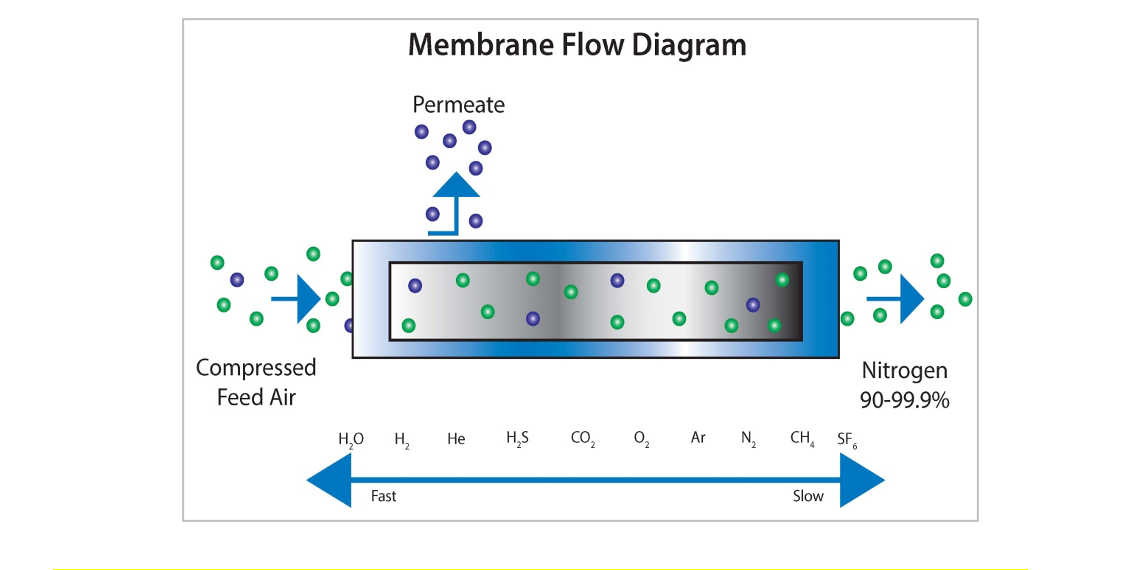 Family of Nitrogen Generators
Family of Nitrogen Generators

Membrane Nitrogen Generator
With more than 2,000 units installed worldwide, the GENERON Group stands as one of the largest membrane nitrogen generator manufacturers in the world.
These patented membrane nitrogen generation systems are designed, engineered, and manufactured to outperform the efficiency of other commercial solutions on the market. Additionally, they are built to meet a robust scope of flow capacities.
Whether you’re interested in outdoor or indoor Cabinet units, Mobile and Container variants, our Marine nitrogen generator series, or our custom built solutions; our units can meet your design and footprint requirements.
Three of our GENERON Group facilities support the fabrication and manufacturing needs of our membrane N2 generation systems. The GENERON Group’s California Facility supports the manufacture of our patented nitrogen membrane modules, and the Texas and China facilities support the remaining system fabrication.
Reasons to Select Nitrogen Generator Membrane Systems from the GENERON Group
- Extensive production experience with membrane and PSA units
- All facilities within the GENERON Group hold ISO 9001 Certification
- Our easy-to-install units have a modular design
- Long-term reliability is a key goal in all our system designs
- Minimal space footprint
- The GENERON Group strategically partners with compressor and dryer suppliers
- We maintain a vast global service network
- Our membrane is top-rated when compared by its ratio of nitrogen/air
Membrane Nitrogen Generation Systems
 NITROGEN ON WALL (NOW) System
NITROGEN ON WALL (NOW) System
- N₂ Capacity: 15 – 2,000 SCFH @ 100 – 175 psig
- Foot Print: 50″ L x 8″ W x 50″ H
 HIGH-PRESSURE SYSTEM
HIGH-PRESSURE SYSTEM
with feed and booster compressor
- N₂ Capacity: up to 1,500 SCFH @ 500 – 5,000 psig
- Foot Print: 72″ L x 36″ W x 76″ H
 CONTAINERIZED SYSTEM
CONTAINERIZED SYSTEM
with internal pre-treatment
- N₂ Capacity: 24,000 – 240,000 SCFH @ 200-500 psig
- Foot Print: 120″-480″ L x 96″ W x 102″ H
 6150 CP SERIES CABINET
6150 CP SERIES CABINET
with internal pre-treatment
- N₂ Capacity: 400-20,000 SCFH @ 100 – 175 psig
- Foot Print: 39″ – 54″ L x 25″ W x 56″ H
 Mobile Trailer Mounted System
Mobile Trailer Mounted System
- N₂ Capacity:30,000 – 90,000 SCFH @ 200 – 500 psig
- Foot Print: 240″ – 480″ L x 96″ W x 102″ H
 6800 CP SERIES CABINET
6800 CP SERIES CABINET
with internal pre-treatment
- N₂ Capacity: 4,000 – 60,000 SCFH @ 100 – 175 psig
- Foot Print: 84″ L x 48″ W x 101″ H
 CUSTOM SKIDDED SYSTEM
CUSTOM SKIDDED SYSTEM
- N₂ Capacity: 1,500 – 110,000 SCFH @ 100 – 450 psig
- Foot Print: 120″ – 480″ L x 96″ W x 102″ H
 6800CP MODULAR SYSTEM
6800CP MODULAR SYSTEM
with external pre-treatment
- N₂ Capacity: 30,000 – 240,000 SCFH @ 100 – 175 psig
- Foot Print: 156″ L x 55″ – 110″ W x 104″ H
Our Nitrogen Membrane Systems Are Used in These Industries
Our membrane-supported nitrogen generators create inert gas for the Chemical Manufacturing, O&G, Refinery, and Marine and Transportation industries. We have been a trusted solution for years, whether customers are using our standard or custom-engineered units for cost-effective and reliable membrane separation.
How Do Membrane Nitrogen Generators Work?
The principle of membrane separation is relatively simple. The core operating principle is built around polymeric membranes the facilitate the passage of one gas while constricting the passage of others. Pressure gradients are used to force gas through this membrane for the desired effect.
This figure illustrates a scale of rates permeation rates for common gases. Our focus is on separating oxygen from the compressed air feed to generate a nitrogen gas stream of high purity. Polymers from the GENERON Group have the minimal unit power consumption and highest separation efficiency. This makes our units the best for permeating gases like He, H2, H2O, H2S, O2, and CO2 through our membrane modules relative to slow gases like N2, Ar, SF6 and CH4.

Membrane modules from the GENERON Group are comprised of more than a million fibers that operate to selectively remove water vapor and oxygen from a compressed air feed that enters the end of the module. The stream of enriched nitrogen can flow from one end to the other. The resulting stream of pure nitrogen is then used for blanketing, production, or stored for future use.
Our membranes synthesize the top membrane materials available with advances fiber bundling and optimal fabrication techniques that create a solution that is cost-effective for producing on-site gas via separation. We have more than 20 patents supporting these technological developments!
Membrane N2 Generator System Configuration (PFD)
See the process diagram below for a description of the basic system employed for our membrane N2 generators. Once you’ve established your exact system options, we will provide a more detailed P&ID for your unique product.

A stream of compressed air is sent to a receiver where any condensate is collected and removed. The air receiver is equipped with a drain line for the condensate that is automatically dumped. The conditioning of compressed air uses our fine and coarse coalescent filters and is standard to our pretreatment system for supply air. The filters used for coalescing remove nearly all the remaining liquid oil and water from the feed air and expels remnants through a drain line.
You have the option of including a process heater in your package that can improve membrane performance by optimizing the temperature of the feed air stream. The superheating of feed air turns any residual process water into vapor.
One the air feed is heated; it passes through a special Activated Carbon bed for further conditioning. This Activated Carbon bed helps remove hydrocarbons that may yet be present due to the process of air compression.
Finally, the supply air goes through its last step of filtration. This helps to make sure any particles from the activated carbon are removed before the air is passed through the Nitrogen Separation Membrane Modules.
The process of air separation happens in the GENERON Group patented Nitrogen Membrane Modules. These modules are in parallel and can each contribute to the increased capacity of the total system.
The permeation of selective gases is the core operating principle for these separation modules. The permeation rates of each gas differ within the membrane. Oxygen and nitrogen separation happens in a cylindrical bunch of hollow-fiber membranes. These hollow-fiber bundles each contain millions of fibers that are each as thin as a human hair. The pressurized, filtered supply air goes in one end of the fiber modules and flows through the fiber bores to the other end.
When the pressurized feed of air comes in contact with the membranes, gas separation occurs. The “fast” gases like carbon dioxide, water vapor, and oxygen permeate through the fiber walls quickly and are sent to a vent port on the module casing’s side. Slower gases like nitrogen don’t permeate the hollow fibers as quickly. Nitrogen gas flows down the fiber bores and leaves the high-pressure module shell through the product air manifold at the end.
The PCV, or Process Control Valve, manages how long the feed air remains in the membrane cylinders. The PCV is fed control signals from an O2 analyzer that directly follows the parallel membrane modules. This system uses a PLC that leverages a PID control loop for keeping the desired time within the membrane units to help meet the target nitrogen purity per the Operator Panel.
If the system determines that the product gas is out of your desired range, there is a product vent valve following the Process Control Valve that allows operators to vent any off-spec gas. The integrated oxygen analyzer helps monitor oxygen content within the product gas and can alert the system operator to vent off-specification product gas when it doesn’t meet the preset purity levels.
This Membrane Nitrogen Generation System from the GENERON Group can be equipped (optional) with a standby mode setting that lets the system go offline when there is no product gas demand. Depending on your target pressure points, the system can be customized to optimize the usage of compressed air.


